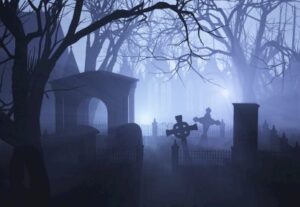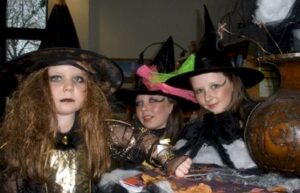Halloween originateds from Celtic Ireland.
Halloween brings out the dark side in us all.
To understand where Halloween originated, it’s necessary to look back at Samhain – an annual Celtic festival celebrating autumn eve – held in Ireland’s Celtic past.

Samhain featured three distinct elements. First was its celebration as an important fire festival, held over 31 October evening and the following day. To mark this event, all old fires had to be extinguished and ceremonially relit by Druids.
As in modern New Year’s Day, this festival also held the idea of clearing away what had come before in preparation for an exciting new beginning.
Our pagan ancestors saw it as the culmination of the pastoral cycle – when crops would have been collected and stored away for winter use and livestock brought in from fields to be slaughtered or selected for breeding.
As it marked the final day of each year, this day marked a day when souls returned home and potentially malevolent spirits surfaced from elsewhere to appear before humanity.
Samhain in the Celtic Calendar
The Celts celebrated four major festivals annually that were not associated with solar cycles in any way. Samhain was an important one of them.

Halloween finds its roots in Celtic autumn festival celebrated on November 1, which in Irish is known as Samhain or All Hallows Eve.
Festivals celebrating Celtic heritage often have different names across Celtic countries; however, their celebrations generally share similar features even if only due to translation issues.
Scottish Gaelic describes its autumn festival as Samhuinn; while Manx refers to it as Sauin.
Root word “sam” denotes summer while fuin indicates its end, signifying more the change in seasons rather than any sort of worship or ritual practice.
Q-Celtic languages (also referred to as Celtic Q) use distinct words with the same intention; Welsh speakers refer to it as Calan Gaeaf for marking the start of winter while in Brittany it’s Kala Goanv which signifies the start of November.
The original Celtic calendar began on 1 February, with Imbolc taking place on February 1st and Beltaine starting May 1. Lughnasa begins in August while Samhain falls on 1st November
Celtic Holidays
The Celts believed that each day began in darkness and progressed towards light; this belief could explain why Winter, with its long, dark nights, marked the start of each year and progressed into lighter days during Spring, Summer, and Autumn.

On 1 November – Samhain – celebrations began and festivities lasted throughout the night on its Eve (ie 30 October).
Harvest was celebrated by Romans during an Autumn festival dedicated to Pomona, goddess of fruit trees such as apples. Halloween special menus that involve apples are likely derivations from this festival; similarly many party games rely heavily on them as part of their formula.
Pomona continued to be celebrated long after Christianity spread throughout Roman Europe.
Samhain became increasingly associated with Celtic culture and folklore over time in Ireland; therefore it was inevitable that an alternative event be instituted that more closely aligned with Christian ideals would emerge to mark it.
Pope Boniface in an effort to lead his flock away from pagan celebrations and rituals declared 1st November as All Saints Day or All Hallows Day.
Hallows’ Eve became synonymous with Halloween. From this point forward, its roots became clear.
Origins of Halloween’s Spookiness
Samhain was an annual spiritual celebration with some mysterious undertones for Celts. However, its importance remains somewhat obscure today.
Being between years, or in transition, meant that the usually secure boundaries between the Otherworld and ours became less secure; meaning puka, banshees, fairies and other spirits could enter and leave more freely; shape shifters could also come and go freely as they saw fit – thus giving rise to Halloween’s darker side.
Samhain marks a time of chaos, when evil spirits unleashed through death and spirits return from beyond the grave to visit their former lives and take revenge on individuals whom they disliked while alive. To combat this danger, bonfires were lit and people donned ugly masks and disguises to disorient spirits that could help prevent spirits from recognising individuals they had disliked during life and prevent the dead from finding out who their real enemies had been.
They would make noise to disturb spirits and drive them from their homes; those more timid would leave out food either in their own homes or near hawthorn or whitethorn bushes where fairies resided, in hopes that generosity would appease the spirits.
Some may regard the tradition of leaving food (usually Champ or Colcannon ) and utensils in their home for their ancestors more as an act of hospitality than an obligation.
Samhain was believed to be an auspicious time for witches’ spells and incantations; its night was believed to be full of signs foretelling what lay ahead in life.
Ireland’s premier Halloween party takes place this year in Derry.

Though Halloween doesn’t originate from Derry specifically, its largest annual party takes place there every year. More than 30,000 revelers take to the streets dressed up as witches, ghosts, vampires or monsters from another realm.
At carnival time, it’s almost certain you’ll hear Banshees screaming – provided that anything can be heard above the sound of marching bands, ceilidh music, hard rock music and calypso as the parade marches through your town.
Waterloo Place plays host to a free concert series, while many events, including Ghost Walks, take place across the city prior to a stunning fireworks display that brings celebrations to an end.